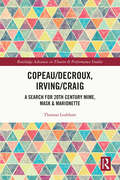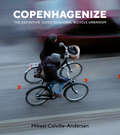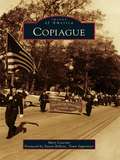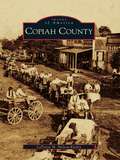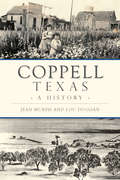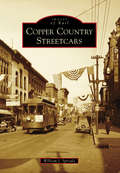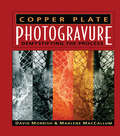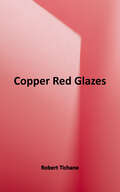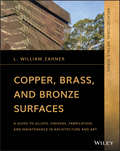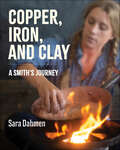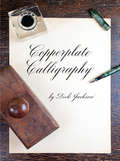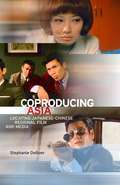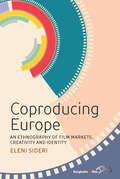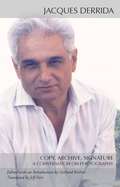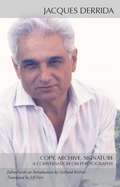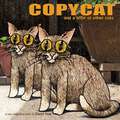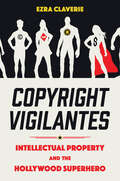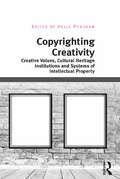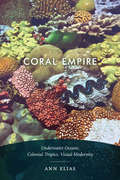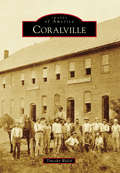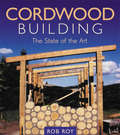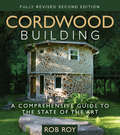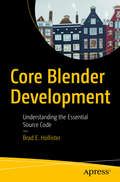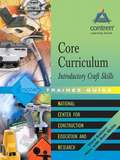- Table View
- List View
Copeau/Decroux, Irving/Craig: A Search for 20th Century Mime, Mask & Marionette (Routledge Advances in Theatre & Performance Studies)
by Thomas G LeabhartIn this series of essays, Thomas Leabhart presents a thorough overview and analysis of Etienne Decroux’s artistic genealogy. After four years’ apprenticeship with Decroux, Thomas Leabhart began to research and discover how forebears and contemporaries might have influenced Decroux’s project. Decades of digging revealed striking correspondences that often led to adjacent fields—art history, philosophy, and anthropology—forays wherein Leabhart’s appreciation of Decroux and his "kinsfolk," who themselves transgressed traditional frontiers, increased. The following essays, composed over a 30-year period, find a common source in a darkened Prague cinema where people gasped at a wooden doll’s sudden reversal of fortune. These essays: investigate the source of that astonishment; continue Leabhart's examination of Decroux’s "family tree"; consider how Copeau's and Decroux's keen observation of animal movement influenced their actor training; record the challenging and paradoxical improvisations chez Decroux; and recall Decroux’s debt to sculpture, poster art, sport and masks. These essays will be of great interest to students, scholars and practitioners in theatre and performance studies.
Copenhagenize: The Definitive Guide to Global Bicycle Urbanism
by Mikael Colville-AndersenThe bicycle enjoyed a starring role in urban history over a century ago, but now it is back, stronger than ever. It is the single most important tool for improving our cities. Designing around it is the most efficient way to make our cities life-sized—to scale cities for humans. It is time to cement the bicycle firmly in the urban narrative in US and global cities.Enter urban designer Mikael Colville-Andersen. He has worked for dozens of global cities on bicycle planning, strategy, infrastructure design, and communication. He is known around the world for his colorful personality and enthusiasm for the role of bike in urban design. In Copenhagenize, he shows cities how to effectively and profitably re-establish the bicycle as a respected, accepted, and feasible form of transportation.Building on his popular blog of the same name, Copenhagenize offers vivid project descriptions, engaging stories, and best practices, alongside beautiful and informative visuals to show how to make the bicycle an easy, preferred part ofeveryday urban life.Copenhagenize will serve as inspiration for everyone working to get the bicycle back into our cities. It will give planners and designers the ammunition to push back against the Automobile Age and convince the skeptics of the value of the life-sized city. This is not a guide on how to become Copenhagen, but how to learn from the successes and failures (yes, failures) of Copenhagen and other cities around the world that are striving to become more livable.We need to act in order to save our cities—and us—from ourselves. Copenhagenize shows the path forward.
Copiague
by Mary Cascone Steven BelloneAlong the shores of Long Island's Great South Bay, the Copiague area was a haven for Native Americans and, later, colonial settlers. Previously known as Huntington South, East Amityville, Great Neck, and Powell's, the hamlet adopted the name Copiague in the 1890s. Pres. George Washington's celebrated 1790 sojourn is one of the high points in Copiague history, as are the visits of famed wireless inventor Guglielmo Marconi in the early 1900s, when he came to review his namesake Marconiville community. In the 1920s, rural Copiague grew to include the beach communities of American Venice, Amity Harbor, and Hawkins Estates and set the stage for the monumental suburban expansion of the 1950s. Beginning in the early 20th century, Copiague also became the adopted home to immigrants from all around the world. Copiague has a rich tradition of community service institutions--its fire department, public schools, veterans' organizations, and churches, including Bethel A.M.E. Church, celebrated as the oldest black church on Long Island.
Copiah County (Images of America)
by LaTricia M. Nelson-EasleyNamed after a Native American word meaning "calling panther," Copiah County was organized after an agreement was reached with the Choctaw Indians in the Treaty of Doak's Stand in 1820. Located 20 miles from the state capital of Jackson, the county was organized in January 1823 and quickly became an agricultural and manufacturing namesake. Once known as the "Tomato Capital of the World," the county was the location of the largest Chautauqua assemblies in the South and the site of the founding of the Mississippi Parent Teacher Association. The extinct town of Brown's Wells once produced spring water that "healed" the rich and famous. Notable citizens from Copiah County include bluesman Robert Johnson; Maj. R. W. Millsaps, for whom Millsaps College was named; Burnita Shelton Matthews, the first female federal district court judge; Pat Harrison, a former representative and senator; Albert Gallatin Brown, a former governor; and Fannye Cook, an author and the first director of the Mississippi Museum of Natural Science.
Coppell, Texas: A History (Brief History)
by Jean Murph Lou DugganCoppell history is rooted in peace and community. In 1843, Sam Houston met with ten native tribes along Grapevine Springs Creek to negotiate an accord to end fighting and allow trade and settlement in the area. When Dallas/Fort Worth International Airport opened in 1974, Coppell transformed from a farming hamlet into a thriving town with expanding economic opportunity. Through firsthand accounts with longtime residents and meticulous research, authors Jean Murph and Lou Duggan unfold the contemplative story of a complex and historic community.
Copper Country Streetcars
by William J. SprouleDuring the early 1900s, copper mining was at its peak in the "Copper Country" of Michigan's Upper Peninsula. Numerous communities sprang up throughout the region, but travel between towns was difficult as the roads were not paved and became impassable during the winter months when over 200 inches of snow would inundate the area. The poor travel conditions and boom period in the Copper Country were instrumental factors that resulted in the construction of a streetcar line to serve the area. Service began in 1900, and the network was extended several times over the next few years. Ridership peaked in 1910, when over six million passengers rode the system; however, it declined in the 1920s as automobiles became more popular, roads were improved, and the copper boom subsided. Service finally ended in 1932. It is a fascinating history that surprises many of today's residents that streetcars operated in the area.
Copper Plate Photogravure: Demystifying the Process (Alternative Process Photography Ser.)
by David Morrish Marlene MacCallumCopper Plate Photogravure describes in comprehensive detail the technique of traditional copper plate photogravure as would be practiced by visual artists using normally available facilities and materials. Attention is paid to step-by-step guidance through the many stages of the process. A detailed manual of technique, Copper Plate Photogravure also offers the history of the medium and reference to past alternative methods of practice.Copper Plate Photogravure: Demystifying the Process is part of the current revitalization of one of the most satisfyingly beautiful image-making processes. The range of ink color and paper quality possibilities is endless. The potential for handwork and alteration of the copper plate provides yet another realm of expressive variation. The subject matter and the treatment are as variable and broad as photography itself. This book's purpose is to demystify and clarify what is a complex but altogether "do-able" photomechanical process using currently available materials. With Copper Plate Photogravure, you will learn how to:· produce a full-scale film positive from a photographic negative· sensitize the gravure tissue to prepare it for exposure to the positive · prepare the plate and develop the gelatin resist prior to etching· prepare the various strengths of etching solutions and etch the plate to achieve a full tonal scale· rework the plate using printmaking tools to correct flaws or to adjust the image for aesthetic reasons· use the appropriate printing inks, ink additives, quality papers, and printshop equipment to produce a high quality printA historical survey and appendices of detailed technical information, charts, and tables are included, as well as a list of suppliers and sources for the materials required, some of which are highly specialized. A comprehensive glossary introduces the non-photographer or non-printmaker to many of the terms particular to those fields and associated with this process.
Copper Red Glazes: A Guide to Producing these Elusive Glazes
by Robert TichaneA reference guide for potters who want success with copper-red glazes without doing extensive and frustrating experimentation. Robert Tichane's approach provides a clear account of the processes involved in the production of copper-red glazes that have relevance for potters beyond copper red.
Copper, Brass, and Bronze Surfaces: A Guide to Alloys, Finishes, Fabrication, and Maintenance in Architecture and Art (Architectural Metals Series)
by L. William ZahnerA FULL-COLOR GUIDE FOR ARCHITECTS AND DESIGN PROFESSIONALS TO THE SELECTION AND APPLICATION OF COPPER, BRASS, AND BRONZE Copper, Brass, and Bronze Surfaces, third in Zahner's Architectural Metals Series, provides a comprehensive and authoritative treatment of copper, brass, and bronze applications in architecture and art. If offers architecture and design professionals the information they need to ensure proper maintenance and fabrication techniques through detailed information and full-color images. It covers everything from the history of the metals and choosing the right alloy, to detailed information on a variety of surface and chemical finishes and corrosion resistance. The book also features case studies that offer strategies for designing and executing successful projects using copper, brass, and bronze. Copper, Brass, and Bronze Surfaces is filled with illustrated case studies that present comprehensive coverage of how each metal is used in creating surfaces for building exteriors, interiors, and art finishes. All the books in Zahner's Architectural Metals Series offer in-depth coverage of today's most commonly used metals in architecture and art. This visual guide: Features full-color images of a variety of copper, brass, and bronze finishes, colors, textures, and forms Includes case studies with performance data that feature strategies on how to design and execute successful projects using copper, brass, and bronze Offers methods to address corrosion, before and after it occurs Explains the significance of the different alloys and the forms available to the designer Discusses what to expect when using copper, brass, and bronze in various exposures Written for architecture professionals, metal fabricators and developers, architecture students, designers, and artists working with metals, Copper, Brass, and Bronze Surfaces offers a logical framework for the selection and application of copper, brass, and bronze in all aspects of architecture.
Copper, Iron, and Clay: A Smith's Journey
by Sara Dahmen“Sara Dahmen's beautifully photographed book is the most useful resource on copper cookware I've come across. An accomplished coppersmith, Sara not only shows us how copper cookware is made, but how to cook with it (along with a myriad of recipes), and care for it, too. The mysteries and mystique of cast-iron and clay cookware are explored in depth as well. Copper, Iron, and Clay is an indispensable cookware reference that every cook should have in their library. I learned so much from it . . . and you will too!” —David Lebovitz, author of My Paris Kitchen and Drinking FrenchA gorgeous, full-color illustrated love letter to our most revered cookware—copper pots, cast-iron skillets, and classic stoneware—and the artistry and workmanship behind them, written by an expert craftsperson, perhaps the only woman coppersmith in America.Today, most people are concerned about eating seasonal, organic, and local food. But we don’t think about how the choices we make about our pots, pans, and bowls can also enhance our meals and our lives. Sara Dahmen believes understanding the origins of the cookware we use to make our food is just as essential. Copper, Iron, and Clay, is a beautiful photographic history of our cooking tools and their fundamental uses in the modern kitchen, accompanied by recipes that showcase the best features of various cooking materials.Interested in history and traditional pioneer kitchens, early cooking methods, and original metals used in pots during the early years of America, Sara became obsessed with the crafts of copper- and tin-smithing for kitchenware—specialty trades that are nearly extinct in the United States today. She embarked on a journey to locate artisans nationwide familiar with the old ways who could teach and inspire her. She began making her own cookware not only to connect with the artisanal traditions of our nation’s past, but to adopt the pioneer kitchen to cook and eat healthier today. Why cook fantastic, healthful food in a cheap pan coated with toxic chemicals and inorganic elements? she asks. If you buy one high-quality item made from natural materials, it can serve your family for generations.Richly illustrated with dozens of stunning color photographs, Copper, Iron, and Clay showcases each material, exploring its fascinating history, fundamental science—including which elements work best for various cooking methods—and its practical uses today. It also features fascinating interviews with industry insiders, including cookware artisans, chefs, entrepreneurs, and manufacturers from around the world. In addition, Sara provides recipes from her own kitchen and some of her famous chef friends, as well as a few historical favorites—all which are optimized for particular kinds of cookware.
Copperplate Calligraphy
by Dick JacksonNo need for copper or plates to achieve the distinctive calligraphic script of eighteenth-century Europe - just a pen, ink, and this comprehensive workbook will do. Master calligrapher Dick Jackson explains the basic strokes for almost all letters of the copperplate alphabet. Simple instructions and examples introduce the swirls, flourishes, strikings, and thick and thin strokes that make copperplate calligraphy a source of pleasure for the practitioner and a delight to the reader.A historical introduction traces the growth of copperplate from its roots in the French ronde of the seventeenth century, to its adaptation by English clerks into their copybooks, and the development of the style known as round hand. In addition, guide sheets and instructions for individual letters and numbers offer aspiring calligraphers a practical approach to this enduring art form.
Copperplate Calligraphy from A to Z: A Step-by-Step Workbook for Mastering Elegant, Pointed-Pen Lettering (Hand-lettering And Calligraphy Practice Ser.)
by Sarah RichardsonLearn to draw the popular classic script with this easy-to-use, full-color, and very modern guide.Pointed pen calligraphy doesn’t have to be intimidating! This photo-packed guide breaks down every skill, step, and stroke into easy-to-learn techniques. It shows you how to build a solid foundation in drawing beautiful letters as well as ways to add flourishes and embellishments to your personal projects. Nothing is overlooked, including:• Step-by-Step Instructions• Color Photos• Practice Pages• Expert Tips and Tricks• DIY Projects• Inspiration and Ideas
Coproducing Asia: Locating Japanese–Chinese Regional Film and Media
by Stephanie DeBoerEast Asia largely functions as a single film and media market, but behind it exists a multifaceted world of coproduction crossing linguistic and national borders. In Coproducing Asia, Stephanie DeBoer guides readers through a rich genealogy of regional film and media coproduction, all the while introducing innovative methods for their examination across decades, locations, and scales of production in East Asia and beyond.Beginning with the present and moving back in time, Coproducing Asia paints a picture of the assemblages of coproduction in East Asia and their negotiation of Cold War geopolitics and imperial legacies along with the emergence of China as a global market. Addressing wide-screen international romances of the early 1960s, technology transfers of Cold War action cinema, Sino–Japanese &“friendship&” TV collaborations, Asian omnibus film and video, and more recent China-centered blockbusters, DeBoer deftly contextualizes each case study while accounting for the difficulties involved in the cultural, creative, and industry mediations associated with coproduction. Based on rarely seen archival research as well as interviews with producers in Tokyo, Hong Kong, Taipei, and Shanghai, Coproducing Asia provides compelling frames for understanding the significance of film and media coproduction in East Asia, making clear that it is not only a site of technological transformation but also an arena for competing senses of regional location and place.
Coproducing Europe: An Ethnography of Film-markets, Creativity and Identity
by Eleni SideriUp until the 1990s, when the EU launched film policies intended to encourage political and cultural collaboration among its member states, film production was based on the cultural and national values of individual nations. Coproducing Europe explores the impact of these EU policies on the coproduction networks that now serve as a driving force in contemporary creative economies. By focusing on regional film markets in Thessasloniki, Sarajevo, and Tbilisi, this comparative ethnography looks beyond the economic nature of film coproductions to their role in Europeanisation, memories of the Cold War, and preconstructed political agendas.
Copy, Archive, Signature: A Conversation on Photography
by Jacques Derrida Jeff Fort Gerhard RichterThis book is based on the interview on the topic of photography that Jacques Derrida granted in 1992 to the German theorist of photography Hubertus von Amelunxen and the German literary and media theorist Michael Wetzel.
Copy, Archive, Signature: A Conversation on Photography
by Jacques Derrida Jeff Fort Gerhard RichterThis book makes available for the first time in English-and for the first time in its entirety in any language-an important yet little-known interview on the topic of photography that Jacques Derrida granted in 1992 to the German theorist of photography Hubertus von Amelunxen and the German literary and media theorist Michael Wetzel. Their conversation addresses, among other things, questions of presence and its manufacture, the technicity of presentation, the volatility of the authorial subject, and the concept of memory. Derrida offers a penetrating intervention with regard to the distinctive nature of photography vis-à-vis related technologies such as cinema, television, and video. Questioning the all-too-facile divides between so-called old and new media, original and reproduction, analog and digital modes of recording and presenting, he provides stimulating insights into the ways in which we think and speak about the photographic image today. Along the way, the discussion fruitfully interrogates the question of photography in relation to such key concepts as copy, archive, and signature. Gerhard Richter introduces the volume with a critical meditation on the relationship between deconstruction and photography by way of the concepts of translation and invention. Copy, Archive, Signature will be of compelling interest to readers in the fields of contemporary European critical thought, photography, aesthetic theory, media studies, and French Studies, as well as those following the singular intellectual trajectory of one the most influential thinkers of our time.
Copycat: and a Litter of Other Cats
by David YowAn irresistible and hilarious book of cat cartoon portraits for all cat lovers, old, young, and in between. “Each page is delightful. These are premium cat drawings, quite worthy of this handsome hardcover book.” —Newcity Lit “David Yow is part punk, part cat lady.” —Brooklyn Paper Also check out The Jesus Lizard Book, featuring exclusive photographs, notes, and commentary from all four members of the Jesus Lizard, including David Yow. David Yow’s cat portraits, captured here for the first time in book form, are bold, striking, hilarious, and beautiful. Each portrait is based around a pun, but they capture so much more than wordplay. All cat lovers will find something to relish in this gorgeous coffee-table book, which is the perfect gift for cat enthusiasts, animal lovers, and anyone with a playful sense of humor. About the book, David Yow says: “I love cats. Always have. The only time I didn’t have a cat was a brief hell in Chicago where I lived in an apartment whose landlord didn’t allow them. At that place, I had a life-sized cardboard cutout of a cat which I named Toody. I also love wordplay. I’m the only adult I hang out with who still gets a kick out of puns. I make up palindromes. I used to write songs and poems (these days, I leave that for the songwriters and poets); in this book of cat-pun drawings, I have made a concerted effort to come up with ideas that range from really funny to really amusing. The entire litter of animals in this book are line drawings that are ‘colored in’ with photographic textures, and each cat is dropped into a photographic setting. Yep, that’s the truth.”
Copyright Vigilantes: Intellectual Property and the Hollywood Superhero
by Ezra ClaverieCopyright Vigilantes: Intellectual Property and the Hollywood Superhero explains superhero blockbusters as allegories of intellectual property relations. In movies based on characters owned by the comics duopoly of DC and Marvel, no narrative recurs more often than a villain’s attempt to copy the superhero's unique powers. In this volume, author Ezra Claverie explains this fixation as a symptom of the films’ mode of production. Since the 1930s, the dominant American comics publishers have treated the creations of artists and writers as work for hire, such that stories and characters become company property. Thus, publishers avoided sharing the profits both from magazine sales and from licensing characters into other media. For decades, creators have challenged this regime, demanding either shares of profits or outright ownership of their creations. Now that the duopoly rents, licenses, and adapts superheroes for increasingly expensive franchises, and for growing international audiences, any challenge to intellectual property relations threatens a production regime worth billions of dollars. Duopoly movies, therefore, present any attempt to break the superhero’s monopoly on their powers as the scheme of terrorists, mad scientists, or space Nazis—assuaging studio anxieties and revealing the fears of those who benefit most from the real-world ownership of superheroes. Weaving together legal analysis, Marxist political economy, and close readings of movies, Copyright Vigilantes explains the preoccupations of Hollywood’s leading genre.
Copyrighting Creativity: Creative Values, Cultural Heritage Institutions and Systems of Intellectual Property (Digital Research in the Arts and Humanities)
by Helle PorsdamWhat is the relationship between creativity, cultural heritage institutions and copyright? Who owns culture and cultural heritage? The digital age has expanded the horizon of creative possibilities for artists and cultural institutions - what is the impact on legal regimes that were constructed for an analogue world? What are the tensions between the safeguarding of cultural heritage and the dissemination of knowledge about culture? Inspired by a three year research project involving leading European universities, this book explores the relationship between copyright and intellectual property, creativity and innovation, and cultural heritage institutions. Its contributors are scholars from both the humanities and the social sciences - from cultural studies to law - as well as cultural practitioners and representatives from cultural heritage institutions. They all share an interest in the contribution of intellectual property to the role of cultural institutions in making culture accessible and encouraging new creativity.
Coral Empire: Underwater Oceans, Colonial Tropics, Visual Modernity
by Ann EliasFrom vividly colored underwater photographs of Australia's Great Barrier Reef to life-size dioramas re-creating coral reefs and the bounty of life they sustained, the work of early twentieth-century explorers and photographers fed the public's fascination with reefs. In the 1920s John Ernest Williamson in the Bahamas and Frank Hurley in Australia produced mass-circulated and often highly staged photographs and films that cast corals as industrious, colonizing creatures, and the undersea as a virgin, unexplored, and fantastical territory. In Coral Empire Ann Elias traces the visual and social history of Williamson and Hurley and how their modern media spectacles yoked the tropics and coral reefs to colonialism, racism, and the human domination of nature. Using the labor and knowledge of indigenous peoples while exoticizing and racializing them as inferior Others, Williamson and Hurley sustained colonial fantasies about people of color and the environment as endless resources to be plundered. As Elias demonstrates, their reckless treatment of the sea prefigured attitudes that caused the environmental crises that the oceans and reefs now face.
Coralville
by Timothy WalchAlthough Coralville is a lot like other small American cities, it is unique as the only community of that name in the United States. Located on the Iowa River, the name refers to the ancient coral reefs that are its geological bedrock. The river has always been a key aspect of Coralville's history, along with its proximity to Iowa City, the first capital of the Territory of Iowa and the home of the University of Iowa. Incorporated as a city in 1873, Coralville had few residents until the 1960s, when dynamic commercial and residential development brought substantial growth to the area. Today, Coralville is a city of industry, commerce, and hospitality. It is not surprising, therefore, that "Coralville Pride" is the city motto.
Cordwood Building
by Rob RoyCordwood masonry is an ancient building technique whereby walls are constructed from "log ends" laid transversely in the wall. It is easy, economical, aesthetically striking, energy-efficient, and environmentally sound.Cordwood Building collects the wisdom of more than 25 of the world's best practitioners, detailing the long history of the method, and demonstrating how to build a cordwood home using the latest and most up-to-date techniques, with a special focus on building code issues.Author/editor Rob Roy has been building, researching, and teaching about cordwood masonry for 25 years and, with his wife, started Earthwood Building School in 1981. He has written 10 books on alternative building, presented four videos--including two about cordwood masonry--and has taught cordwood masonry all over the world.
Cordwood Building: A Comprehensive Guide to the State of the Art
by Rob RoyCordwood masonry walls are low-cost, easy to build, aesthetically pleasing, and score high environmental points for making use of low-impact materials. This fully revised second edition of the most widely read and used book on cordwood construction presents the latest innovations and on-the-ground experience from four decades of cordwood building and research. New chapters cover the practical how-to and the full depth and breadth of cordwood construction, including load-bearing and non-load-bearing walls, integrating electrical wiring, innovations on corner designs, new mortar options such as lime putty, and the latest on cob-cordwood, insulation options, and bottle-end designs. There is detailed treatment of code compliance, efficient house shapes, and design considerations. Richly illustrated and augmented with fresh case studies ranging from Hawaii and the Adirondacks to Tasmania and Michigan, Cordwood Building remains the most comprehensive book available on cordwood masonry construction methods. Rob Roy has been building, researching and teaching about cordwood masonry for four decades. Widely recognized as a world leading authority on cordwood construction, Rob started Earthwood Building School in 1981 to train builders in the latest cordwood building methods. He has authored and edited a dozen books on alternative and natural building including the first edition of Cordwood Building, Timber Framing for the Rest of Us, Earth-Sheltered Houses, and Stoneview. Rob has also presented four videos, including two about cordwood, and has taught cordwood masonry all over the world.
Core Blender Development: Understanding the Essential Source Code
by Brad E. HollisterLearn the essential source code of Blender and its unique build system. This book provides the inner workings of the Blender C-based source code, and will be indispensable for those wanting to contribute to this important open-source project.Blender is an open-source 3D modeling and rendering software package used in the production of assets for animated projects, 3D printing, games, and even scientific visualization. This book goes in depth and discusses the primary modules related to the GUI and the geometric modeling work. You'll start by learning how to reverse engineer geometric operators, and from there move on to the main features of the source code and how to apply them. When done, you'll have the necessary foundation for exploration in other modules of the Blender source code. Lack of software engineering knowledge, such as experience with large cross-platform code base, remains insurmountable for many new developers. While the Blender site includes much useful information, it is not detailed enough. Core Blender Development breaks down the barriers to entry for open-source development in 3-D modeling. What You’ll LearnFind the code for various functions and editors in BlenderTrack down bugs, and contribute new functionality to the Blender code baseExamine the .blend file and how it stores Blender stateUnderstand the Blender core code base beyond the community website documentationReview the explicit code traces and source files of descriptions of the code baseWho This Book Is ForPrimarily for novice to intermediate level developers and programmers with an interest in Blender, graphics, and visualization, who likely don’t have experience of reverse engineering a large code base.
Core Curriculum: Introductory Craft Skills
by Pearson EducationThis exceptionally produced trainee guide features a highly illustrated design, technical hints and tips from industry experts, review questions and a whole lot more! Key content includes Basic Safety, Introduction to Construction Math, Introduction to Hand Tools, Introduction to Power Tools, Introduction to Blueprints, Basic Rigging, Basic Communication Skills, Employability Skills.
